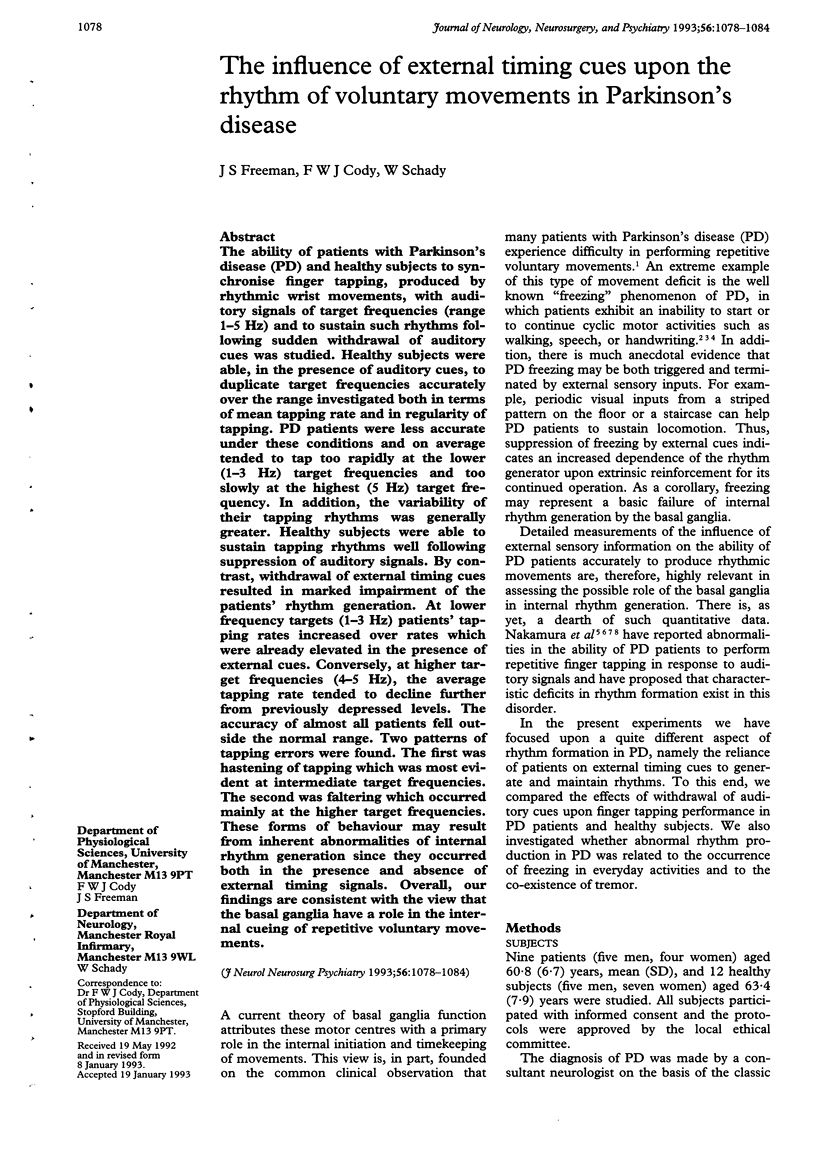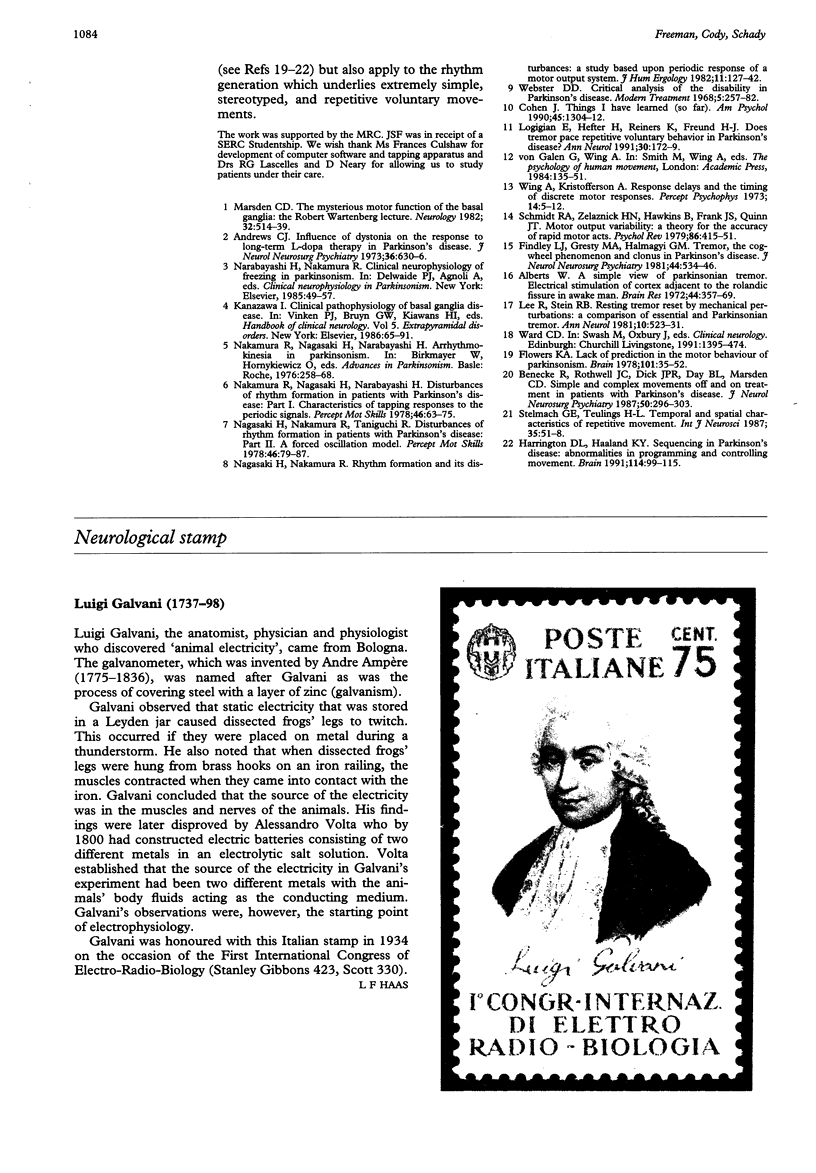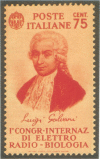Abstract
The ability of patients with Parkinson's disease (PD) and healthy subjects to synchronise finger tapping, produced by rhythmic wrist movements, with auditory signals of target frequencies (range 1-5 Hz) and to sustain such rhythms following sudden withdrawal of auditory cues was studied. Healthy subjects were able, in the presence of auditory cues, to duplicate target frequencies accurately over the range investigated both in terms of mean tapping rate and in regularity of tapping. PD patients were less accurate under these conditions and on average tended to tap too rapidly at the lower (1-3 Hz) target frequencies and too slowly at the highest (5 Hz) target frequency. In addition, the variability of their tapping rhythms was generally greater. Healthy subjects were able to sustain tapping rhythms well following suppression of auditory signals. By contrast, withdrawal of external timing cues resulted in marked impairment of the patients' rhythm generation. At lower frequency targets (1-3 Hz) patients' tapping rates increased over rates which were already elevated in the presence of external cues. Conversely, at higher target frequencies (4-5 Hz), the average tapping rate tended to decline further from previously depressed levels. The accuracy of almost all patients fell outside the normal range. Two patterns of tapping errors were found. The first was hastening of tapping which was most evident at intermediate target frequencies. The second was faltering which occurred mainly at the higher target frequencies. These forms of behaviour may result from inherent abnormalities of internal rhythm generation since they occurred both in the presence and absence of external timing signals. Overall, our findings are consistent with the view that the basal ganglia have a role in the internal cueing of repetitive voluntary movements.
Full text
PDF






Images in this article
Selected References
These references are in PubMed. This may not be the complete list of references from this article.
- Alberts W. W. A simple view of Parkinsonian tremor. Electrical stimulation of cortex adjacent to the Rolandic fissure in awake man. Brain Res. 1972 Sep 29;44(2):357–369. doi: 10.1016/0006-8993(72)90308-3. [DOI] [PubMed] [Google Scholar]
- Andrews C. J. Influence of dystonia on the response to long-term L-dopa therapy in Parkinson's disease. J Neurol Neurosurg Psychiatry. 1973 Aug;36(4):630–636. doi: 10.1136/jnnp.36.4.630. [DOI] [PMC free article] [PubMed] [Google Scholar]
- Benecke R., Rothwell J. C., Dick J. P., Day B. L., Marsden C. D. Simple and complex movements off and on treatment in patients with Parkinson's disease. J Neurol Neurosurg Psychiatry. 1987 Mar;50(3):296–303. doi: 10.1136/jnnp.50.3.296. [DOI] [PMC free article] [PubMed] [Google Scholar]
- Findley L. J., Gresty M. A., Halmagyi G. M. Tremor, the cogwheel phenomenon and clonus in Parkinson's disease. J Neurol Neurosurg Psychiatry. 1981 Jun;44(6):534–546. doi: 10.1136/jnnp.44.6.534. [DOI] [PMC free article] [PubMed] [Google Scholar]
- Flowers K. Lack of prediction in the motor behaviour of Parkinsonism. Brain. 1978 Mar;101(1):35–52. doi: 10.1093/brain/101.1.35. [DOI] [PubMed] [Google Scholar]
- Harrington D. L., Haaland K. Y. Sequencing in Parkinson's disease. Abnormalities in programming and controlling movement. Brain. 1991 Feb;114(Pt 1A):99–115. [PubMed] [Google Scholar]
- Lee R. G., Stein R. B. Resetting of tremor by mechanical perturbations: a comparison of essential tremor and parkinsonian tremor. Ann Neurol. 1981 Dec;10(6):523–531. doi: 10.1002/ana.410100606. [DOI] [PubMed] [Google Scholar]
- Logigian E., Hefter H., Reiners K., Freund H. J. Does tremor pace repetitive voluntary motor behavior in Parkinson's disease? Ann Neurol. 1991 Aug;30(2):172–179. doi: 10.1002/ana.410300208. [DOI] [PubMed] [Google Scholar]
- Marsden C. D. The mysterious motor function of the basal ganglia: the Robert Wartenberg Lecture. Neurology. 1982 May;32(5):514–539. doi: 10.1212/wnl.32.5.514. [DOI] [PubMed] [Google Scholar]
- Nagasaki H., Nakamura R. Rhythm formation and its disturbances--a study based upon periodic response of a motor output system. J Hum Ergol (Tokyo) 1982 Dec;11(2):127–142. [PubMed] [Google Scholar]
- Nagasaki H., Nakamura R., Taniguchi R. Disturbances of rhythm formation in patients with Parkinson's disease: part II. a forced oscillation model. Percept Mot Skills. 1978 Feb;46(1):79–87. doi: 10.2466/pms.1978.46.1.79. [DOI] [PubMed] [Google Scholar]
- Nakamura R., Nagasaki H., Narabayashi H. Disturbances of rhythm formation in patients with Parkinson's disease: part I. Characteristics of tapping response to the periodic signals. Percept Mot Skills. 1978 Feb;46(1):63–75. doi: 10.2466/pms.1978.46.1.63. [DOI] [PubMed] [Google Scholar]
- Schmidt R. A., Zelaznik H., Hawkins B., Frank J. S., Quinn J. T., Jr Motor-output variability: a theory for the accuracy of rapid motor acts. Psychol Rev. 1979 Sep;47(5):415–451. [PubMed] [Google Scholar]
- Stelmach G. E., Teulings H. L. Temporal and spatial characteristics in repetitive movement. Int J Neurosci. 1987 Jul;35(1-2):51–58. doi: 10.3109/00207458708987109. [DOI] [PubMed] [Google Scholar]
- Webster D. D. Critical analysis of the disability in Parkinson's disease. Mod Treat. 1968 Mar;5(2):257–282. [PubMed] [Google Scholar]



